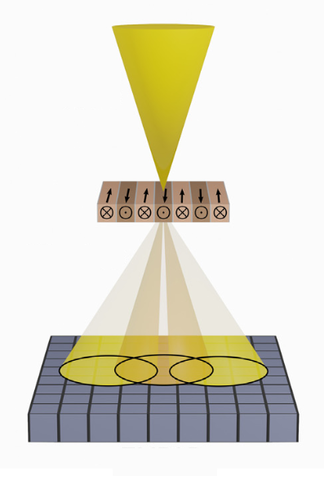Realizing the full potential of antiferromagnetic devices will require sensing their atom-to-atom magnetic patterns, something that has not yet been achieved. However, researchers at the University of Illinois Urbana-Champaign led by Pinshane Huang, MatSE associate professor and Ivan Racheff Faculty Scholar, have made progress toward this goal. In the journal Ultramicroscopy, they report a new electron microscopy technique that can resolve magnetic behavior on the scale of angstroms — tenths of nanometers, nearly on the scale of individual atoms. They use this technique to fully resolve the antiferromagnetic order in iron arsenide for the first time.
“We are working to develop new techniques that can resolve magnetic behavior of individual atoms, and this study is an important step,” Pinshane Huang said. “The best techniques before now have achieved resolutions of a few nanometers. We have vastly exceeded that record.”
Microscopic magnetism is often measured with scanning transmission electron microscopy, or STEM, in which an electron beam is focused into a material. The electric interactions between the beam and the material’s structure have been famously used to provide images of individual atoms in the material, but the beam also interacts with the material’s magnetic structure.
Although this much weaker interaction is enough to determine the longer-range magnetic order found in ferromagnets, a far more precise technique is needed to observe the atom-to-atom variation in antiferromagnets.
“In standard, low-resolution STEM experiments, the magnetic interaction can be understood as a small deflection of the electron beam,” said Kayla Nguyen, a MatSE postdoctoral research associate and co-lead author of the study. “On the scale of individual atoms, though, this picture breaks down. The magnetic interactions create complicated and subtle signals in the beam pattern which require new tools to analyze and understand.”
To achieve higher resolution, the researchers turned to a more powerful method called four-dimensional STEM. Standard STEM techniques record drops in the beam’s intensity as it interacts with the material, but 4D-STEM captures full two-dimensional scattering patterns as the electron beam scans along the two directions of the material’s surface — for four-dimensional data. These data allowed the researchers to search the full beam patterns for the more intricate signals of atomic antiferromagnetism.

4D-STEM performed on a sample of iron arsenide. An electron beam from the top is directed into a sample of the antiferromagnet. The effects of the magnetic order on the beam pattern are observed in the detector at the bottom.
A crucial step of the analysis was simulating the magnetic fields within the iron arsenide sample, for which the researchers wrote a software package called Magnstem. MatSE graduate student and co-lead author Jeffrey Huang explained that the package allowed them to add magnetic effects specific to their material and study the effects they had on electron beam patterns.
“Magnstem simulations allowed us to compare the electron patterns with magnetic effects turned on versus turned off, something that would be quite difficult to do in a real experiment,” he said. “We saw that the effects of the magnetic and electric signals occur on different parts of the pattern and can be extracted separately.”
By combining 4D-STEM with Magnstem simulations, the researchers resolved magnetic order down to 6 angstroms. While this does not resolve magnetic effects on the scale of individual atoms, it allowed them to resolve the antiferromagnetic pattern of iron arsenide, which repeats in cells of 12 atoms.
“Our work has shown it is possible to resolve small-scale magnetic order in electron microscopy experiments and in simulations, almost at atomic resolution,” Pinshane Huang said. “We are actively developing techniques that will build on this result.”
Read the original article on University of Illinois Urbana-Champaign.
